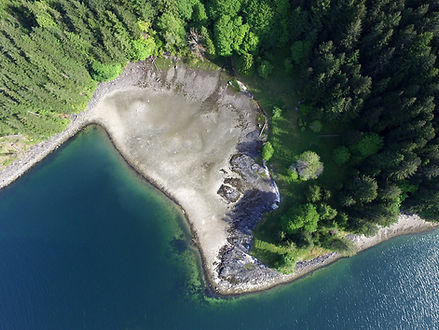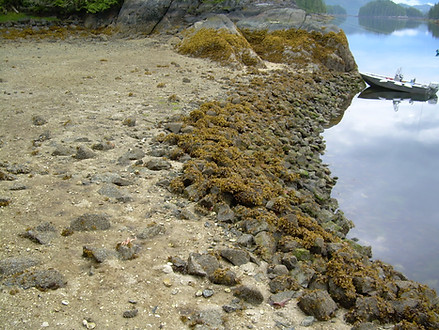
Clam gardens are made by constructing rock walls at the low tide line along the edges of bays and inlets, transforming naturally sloping beaches or rocky shorelines into productive, level beach terraces. By building the walls at particular heights in relationship to the tides (“tidal heights”), these features expand the zone of the beach where clams thrive, and when built on bedrock or rocky slopes, they create entirely new clam habitat.
Diagram created by Dana Lepofsky
Clam garden terraces can range in size from a few square meters to well over a kilometer in length. These larger beaches are more like fields than “gardens.” In some regions, clam gardens were built wherever there was available shoreline, amounting to as much as a 33% increase in clam habitat. According to local knowledge, clam habitat was enhanced on all clamming beaches, including clam gardens, by clearing away large rocks, by removing predators, and by tilling the sediment. These practices, coupled with the building of the terraces, created highly productive clam habitat that sustained communities for generations.


Keith Holmes
John Harper
While there is also some variation in clam garden form, all are composed of a rough rock wall at the lowest-low tide mark. Rocks are rolled, carried, or floated via canoe or beach logs into the wall. Our excavations suggest that some walls were built to a particular height in a single building event (with rubble fill at the center of the wall), while others seem to have been built up more gradually.
According to Heiltsuk Knowledge holder Davie Wilson and the W̱SÁNEĆ Clam Garden Restoration Project Report, once a wall is substantial enough to trap sediments, silts, sands, gravels, and broken shell, this accumulation landward of the wall plus the intentional addition of gravel and clam shell eventually formed the terraces we see today.
Clam gardens today are 150 – 300% more productive than beaches without gardens. These staggering numbers suggest that management techniques honed over multiple generations have much to teach us about our current use of shellfish. Additionally, the demand for seafood exceeds what is locally available and sustainable in many parts of the world, making traditional methods for managing clams relevant to contemporary concerns about food security

Google Earth Image
Clam gardens have been recorded or observed from Alaska, through British Columbia, and into Washington State. There are probably hundreds, if not thousands, of clam gardens that have yet to be recorded along the Northwest Coast. Rising or dropping sea levels, lack of surveying, and industrial development of the foreshore are among the main reasons why modified beaches are yet to be identified in some regions. Mapping the locations of these features is slow-going. Given that most clam gardens are situated at today’s low-low tide levels, there are only about 40 to 80 daylight hours per year (May – September) when they are visible.
"At a place called Klelung, or Orcas Island, there is a clam bed cultivated by its owners. They took the largest rocks that were in the clam bed and moved them out to extreme low water marks, setting them in rows like a fence along the edge of the water. This made clam digging very easy compared to what it had previously been because there are only small pebbles and sand to dig in. It is exceptional to cultivate clam beds in this manner and while other clam beds are used by everyone in the tribe, here only the owners who cultivated the bed gathered.”
- Earliest written account of clam gardens, B. Stern 1934:47



